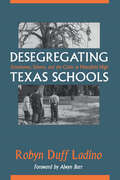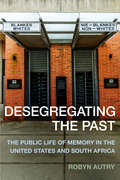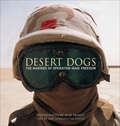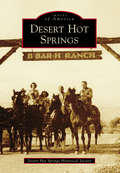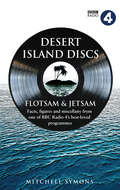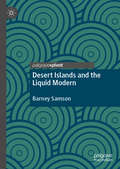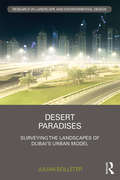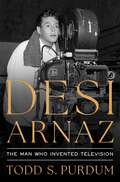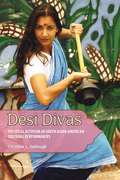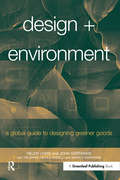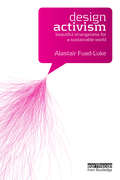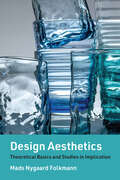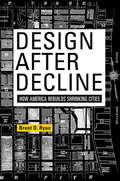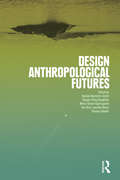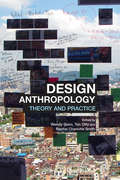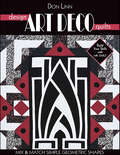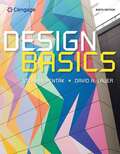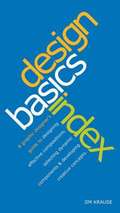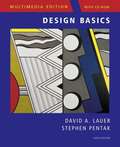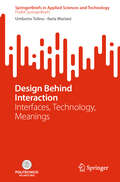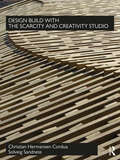- Table View
- List View
Desegregating Texas Schools: Eisenhower, Shivers, and the Crisis at Mansfield High
by Robyn Duff LadinoIn the famous Brown v. the Board of Education decisions of 1954 and 1955, the United States Supreme Court ruled that "separate but equal" schools for black and white students were unconstitutional. Yet history records that it took more than a decade of legal battles, civil rights protests, and, tragically, violent confrontations before black students gained full access to previously white schools. Mansfield, Texas, a small community southeast of Fort Worth, was the scene of an early school integration attempt. In this book, Robyn Duff Ladino draws on interviews with surviving participants, media reports, and archival research to provide the first full account of the Mansfield school integration crisis of 1956. Ladino explores how power politics at the local, state, and federal levels ultimately prevented the integration of Mansfield High School in 1956. Her research sheds new light on the actions of Governor Allan Shivers—who, in the eyes of the segregationists, actually validated their cause by his political actions—and it underscores President Dwight Eisenhower's public passivity toward civil rights during his first term of office. Despite the short-term failure, however, the Mansfield school integration crisis helped pave the way for the successful integration of Central High School in Little Rock, Arkansas, in 1957. Thus, it deserves a permanent place in the history of the civil rights movement, which this book amply provides.
Desegregating the Past: The Public Life of Memory in the United States and South Africa
by Robyn AutryAt the Apartheid Museum in Johannesburg, South Africa, visitors confront the past upon arrival. They must decide whether to enter the museum through a door marked "whites" or another marked "non-whites." Inside, along with text, they encounter hanging nooses and other reminders of apartheid-era atrocities. In the United States, museum exhibitions about racial violence and segregation are mostly confined to black history museums, with national history museums sidelining such difficult material. Even the Smithsonian's National Museum of African American History and Culture is dedicated not to violent histories of racial domination but to a more generalized narrative about black identity and culture. The scale at which violent racial pasts have been incorporated into South African national historical narratives is lacking in the U.S. Desegregating the Past considers why this is the case, tracking the production and display of historical representations of racial pasts at museums in both countries and what it reveals about underlying social anxieties, unsettled emotions, and aspirations surrounding contemporary social fault lines around race. Robyn Autry consults museum archives, conducts interviews with staff, and recounts the public and private battles fought over the creation and content of history museums. Despite vast differences in the development of South African and U.S. society, Autry finds a common set of ideological, political, economic, and institutional dilemmas arising out of the selective reconstruction of the past. Museums have played a major role in shaping public memory, at times recognizing and at other times blurring the ongoing influence of historical crimes. The narratives museums produce to engage with difficult, violent histories expose present anxieties concerning identity, (mis)recognition, and ongoing conflict.
Desert Dogs: The Marines of Operation Iraqi Freedom
by Amy Goodpaster Strebe Russ BryantA photographic account that highlights the human side of war, the day-in-the-life of US Marines stationed in Iraq.Desert Dogs includes dramatic, harrowing, and simply unbelievable images of the marines of Operation Iraqi Freedom, personal letters, and stories of coping with the pain of separation from their families and the horrors of war. Russ Bryant’s photography chronicles every aspect of the daily lives of these marines: lazy camels amble by a cargo drop; blinding sandstorms threaten to blow away tents, supplies, and marines alike; Scud missile attack sirens send marines scuttling to their bunkers; sniper fire crisscrosses marine convoys moving into Iraq; tanks and bombs topple the portraits of Saddam that seem to loom over every Iraqi village; shelled-out tanks, armored vehicles, and even busses litter the road on the way to Baghdad; medical personnel attend to fallen marines and prisoners alike; the occasional silent interlude allows time for prayer and remembrance.
Desert Hot Springs
by Desert Hot Springs Historical SocietyCabot Yerxa's discovery of natural hot and cold mineral water in 1914 was the impetus for the establishment of Desert Hot Springs. His eccentric pueblo-style home, which is listed in the National Register of Historic Places, is a unique tourist attraction. L.W. Coffee also recognized the value of the hot water, so he drilled wells and opened his famous bathhouse in 1941. The development of more than 200 spas followed. Angel View Children's Hospital, established in the 1950s, uses the therapeutic water to treat disabled children. The city's extraordinary, pure cold water wins awards such as "best tasting in the world." Desert Hot Springs is the location of architect John Lautner's first desert commission, and Mary Pickford's house still stands at the famous B-Bar-H Ranch that was frequented by movie stars during the 1940s and 1950s. The historic Two Bunch Palms Resort and Spa is known as an exclusive celebrity hideaway. The city, believed to have an unusually strong vortex, is located just south of Joshua Tree National Park. An elevation of 1,200 feet affords most residents magnificent views of both Mount San Jacinto and Mount San Gorgonio.
Desert Island Discs: Fascinating facts, figures and miscellany from one of BBC Radio 4’s best-loved programmes
by Mitchell SymonsFlotsam & Jetsam is the ultimate trivia book for fans of the popular BBC Radio 4 programme Desert Island Discs, and a fascinating introduction for all those who have yet to discover its delights.Taking the reader through seven decades of wonderful entertainment, here is an absorbing range of facts, figures and miscellany – including who chose what, and why. It also reveals much about the castaways' drives and motivations, their influences and, of course, their lives.Spanning the early years with the original presenter, Roy Plomley, and the present day, the Desert Island Discs programme has brought its own unique surprises to listeners, some very personal, some humorous, such as Eric Morecambe's choice of a deckchair as his luxury and Ernie Wise's of a deckchair ticket machine.From Beethoven to the Beatles, from chessboards and chocolate to Jane Austen and Zola, Flotsam & Jetsam is the perfect companion guide to the national treasure that is Desert Island Discs.
Desert Islands and the Liquid Modern
by Barney SamsonThis book investigates desert islands in postwar anglophone popular culture, exploring representations in radio, print and screen advertising, magazine cartoons, cinema, video games, and comedy, drama and reality television. Drawing on Zygmunt Bauman’s theory of liquid modernity, desert island texts are analysed in terms of their intersections with repressive and seductive mechanisms of power. Chapters focus on the desert island as: a conflictingly in/coherent space that characterises identity as deferred and structured by choice; a location whose ‘remoteness’ undermines satirical critiques of communal identity formation; a site whose ambivalent relationship with ‘home’ and Otherness destabilises patriarchal ‘Western’ subjectivity; a space bound up with mobility and instantaneity; and an expression of radical individuality and underdetermined identity. The desert island in popular culture is shown to reflect, endorse and critique a profoundly consumerist society that seduces us with promises of coherence, with the threat of repression looming if we do not conform.
Desert Paradises: Surveying the Landscapes of Dubai’s Urban Model (Routledge Research in Landscape and Environmental Design)
by Julian BolleterDesert Paradises: Surveying the Landscapes of Dubai’s Urban Model explores how designed landscapes can play a vital role in constructing a city’s global image and legitimizing its socio-political hierarchy. Using the case study of Dubai, Bolleter explores how Dubai’s rulers employ a paradisiacal image of greening the desert, in part, as a tool for political legitimization. Bolleter also evaluates the designed landscapes of Dubai against the principles of the United Nations and the International Federation of Landscape Architects and argues that what is happening in Dubai represents a significant discrepancy between theory and practice. This book offers a new perspective on landscape design that has until now been unexplored. It would be beneficial to academics and students of geography, landscape architecture, urban design and urban planning – particularly those with an interest in Dubai or the many cities in the region that are experiencing Dubaiification.
Deserting from the Culture Wars
by Maria Hlavajova Sven LüttickenArtists and writers consider a tactical desertion from the "culture wars"--a refusal to be distracted, an embrace of the emancipatory understanding of culture.Deserting from the Culture Wars reflects upon and intervenes in our current moment of ever-more polarizing ideological combat, often seen as the return of the "culture wars." How are these culture wars defined and waged? Engaging in a theater of war that has been delineated by the enemy is a shortcut to defeat. Getting out of the reactive mode that produces little but a series of Pavlovian responses, this book proposes a tactical desertion from the culture wars as they are being waged today--a refusal to play the other side's war games, an unwillingness to be distracted.
Desi Arnaz: The Man Who Invented Television
by Todd S PurdumAn illuminating biography of Desi Arnaz, the visionary, trailblazing Cuban American who revolutionized television and brought laughter to millions as Lucille Ball&’s beloved husband on I Love Lucy, leaving a remarkable legacy that continues to influence American culture today.Desi Arnaz is a name that resonates with fans of classic television, but few understand the depth of his contributions to the entertainment industry. In Desi Arnaz, Todd S. Purdum offers a captivating biography that dives into the groundbreaking Latino artist and businessman known to millions as Ricky Ricardo from I Love Lucy. Beyond his iconic role, Arnaz was a pioneering entrepreneur who fundamentally transformed the television landscape. His journey from Cuban aristocracy to world-class entertainer is remarkable. After losing everything during the 1933 Cuban revolution, Arnaz reinvented himself in pre-World War II Miami, tapping into the rising demand for Latin music. By twenty, he had formed his own band and sparked the conga dance craze in America. Behind the scenes, he revolutionized television production by filming I Love Lucy before a live studio audience with synchronized cameras, a model that remains a sitcom gold standard today. Despite being underestimated due to his accent and origins, Arnaz&’s legacy is monumental. Purdum&’s biography, enriched with unpublished materials and interviews, reveals the man behind the legend and highlights his enduring contributions to pop culture and television. This book is a must-read biography about innovation, resilience and the relentless drive of a man who changed TV forever.
Desi Divas: Political Activism in South Asian American Cultural Performances
by Christine L. GarloughDesi Divas: Political Activism in South Asian American Cultural Performances is the product of five years of field research with progressive activists associated with the School for Indian Languages and Cultures (SILC), South Asian Americans Leading Together (SAALT), the feminist dance collective Post Natyam, and the grassroots feminist political organization South Asian Sisters. Christine L. Garlough explores how traditional cultural forms may be critically appropriated by marginalized groups and used as rhetorical tools to promote deliberation and debate, spur understanding and connection, broaden political engagement, and advance particular social identities. Within this framework she examines how these performance activists advocate a political commitment to both justice and care, to both deliberative discussion and deeper understanding. To consider how this might happen in diasporic performance contexts, Garlough weaves together two lines of thinking. One grows from feminist theory and draws upon a core literature concerning the ethics of care. The other comes from rhetoric, philosophy, and political science literature on recognition and acknowledgment. This dual approach is used to reflect upon South Asian American women's performances that address pressing social problems related to gender inequality, immigration rights, ethnic stereotyping, hate crimes, and religious violence. Case study chapters address the relatively unknown history of South Asian American rhetorical performances from the early 1800s to the present. Avant-garde feminist performances by the Post Natyam dance collective appropriate women's folk practices and Hindu goddess figures make rhetorical claims about hate crimes against South Asian Americans after 9/11. In Yoni ki Bat (a South Asian American version of The Vagina Monologues) a progressive performer transforms aspects of the Mahabharata narrative to address issues of sexual violence, such as incest and rape. Throughout the volume, Garlough argues that these performers rely on calls for acknowledgment that intertwine calls for justice and care. That is, they embed their testimony in traditional cultural forms to invite interest, reflection, and connection.
Design & Knit the Sweater of Your Dreams
by J. Marsha MichlerDesigning and creating a sweater is fun and can be accomplished by knitters of all skill levels!J. Marsha Michler guides the reader through three main design and construction areas:Creating pattern stitches and colorworkingSweater shapes and stylesHow to fit a sweaterEach is explained fully and clearly, and allows for the reader to participate through worksheets. Also includes helpful tips, diagrams, and detailed photos. This book is a reference, textbook, and workbook that will inspire knitters to create beautiful sweaters they will want to wear again and again. Covers four different styles of sweaters and provides instructions for designing and knitting more than 18 sweaters, along with helpful hints that assist the reader in making creative choices.Create beautiful sweaters to wear with pride!
Design + Environment: A Global Guide to Designing Greener Goods
by Helen Lewis Tim Grant John Gertsakis Nicola Morelli Andrew SweatmanThere is a huge scarcity of good, practical resources for designers and students interested in minimizing the environmental impacts of products. Design + Environment has been specifically written to address this paucity. The book first provides background information to help the reader understand how and why design for environment (DfE) has become so critical to design, with reference to some of the most influential writers, designers and companies in the field. Next, Design + Environment provides a step-by-step approach on how to approach DfE: to design a product that meets requirements for quality, cost, manufacturability and consumer appeal, while at the same time minimising environmental impacts. The first step in the process is to undertake an assessment of environmental impacts, using life-cycle assessment (LCA) or one of the many simpler tools available to help the designer. From then on, DfE becomes an integral part of the normal design process, including the development of concepts, design of prototypes, final design and development of marketing strategies. Environmental assessment tools and strategies to reduce environmental impacts, such as the selection of appropriate materials, are then discussed. Next, some of the links between environmental problems, such as global warming, ozone depletion, water and air pollution and the everyday products we consume are considered. In order to design products with minimal environmental impact, we need to have a basic understanding of these impacts and the interactions between them. The four subsequent chapters provide more detailed strategies and case studies for particular product groups: packaging, textiles, furniture, and electrical and electronic products. Guidelines are provided for each of the critical stages of a product's life, from the selection of raw materials through to strategies for recovery and recycling. Finally, Design + Environment takes a look at some of the emerging trends in DfE that are offering us the opportunity to make a more significant reduction in environmental impacts. Both the development of more sustainable materials and technologies and the growing interest in leasing rather than selling products are examined. Design + Environment is organized as a workbook rather than an academic text. It should be read once, and then used as a key reference source. This clear and informative book will prove to be invaluable to practising designers, to course directors and their students in need of a core teaching and reference text and to all those interested in learning about the tools and trends influencing green product design. The authors have all been involved in an innovative demonstration programme called "EcoReDesign", which was developed by the Centre for Design at RMIT University with funding from the Australian government. The Centre successfully collaborated with Australian companies to improve the environmental performance of their products by following DfE principles.
Design Activism: Beautiful Strangeness for a Sustainable World
by Alastair Fuad-LukeDesign academics and practitioners are facing a multiplicity of challenges in a dynamic, complex, world moving faster than the current design paradigm which is largely tied to the values and imperatives of commercial enterprise. Current education and practice need to evolve to ensure that the discipline of design meets sustainability drivers and equips students, teachers and professionals for the near-future. New approaches, methods and tools are urgently required as sustainability expands the context for design and what it means to be a 'designer'. Design activists, who comprise a diverse range of designers, teachers and other actors, are setting new ambitions for design. They seek to fundamentally challenge how, where and when design can catalyse positive impacts to address sustainability. They are also challenging who can utilise the power of the design process. To date, examination of contemporary and emergent design activism is poorly represented in the literature. This book will provide a rigorous exploration of design activism that will re-vitalise the design debate and provide a solid platform for students, teachers, design professionals and other disciplines interested in transformative (design) activism. Design Activism provides a comprehensive study of contemporary and emergent design activism. This activism has a dual aim - to make positive impacts towards more sustainable ways of living and working; and to challenge and reinvigorate design praxis,. It will collate, synthesise and analyse design activist approaches, processes, methods, tools and inspirational examples/outcomes from disparate sources and, in doing so, will create a specific canon of work to illuminate contemporary design discourse. Design Activism reveals the power of design for positive social and environmental change, design with a central activist role in the sustainability challenge. Inspired by past design activists and set against the context of global-local tensions, expressions of design activism are mapped. The nature of contemporary design activism is explored, from individual/collective action to the infrastructure that supports it generating powerful participatory design approaches, a diverse toolbox and inspirational outcomes. This is design as a political and social act, design to enable adaptive societal capacity for co-futuring.
Design Aesthetics: Theoretical Basics and Studies in Implication (Design Thinking, Design Theory Ser.)
by Mads Nygaard FolkmannAn original exploration of the role of aesthetics in contemporary design, uniquely combining philosophical aesthetics and cultural analysis of design.As a product of human ingenuity, design functions as an artificial interface through which we meet the world. While the ubiquity of design seems to render it imperceptible, when we truly reflect on design, we see that it is inextricably entwined with our experience of the world. In Design Aesthetics, Mads Nygaard Folkmann provides an engaging introduction to the field of design aesthetics and its role as a concept. Engaging with sensual, conceptual, and contextual considerations of design aesthetics, this book investigates design experience in tandem with design practice, objects, and perception.Part one of Design Aesthetics lays the theoretical foundation by differentiating between sensual, conceptual, and contextual dimensions of design aesthetics and clarifying what &“aesthetic experience&” means in relation to design. The second part of the book consists of studies in implications of design aesthetics for design practice, design objects with embedded technology, and the construction of perception of aesthetic qualities in objects. In its focus on design aesthetics, the book is intended for everyone working with design—design students, designer researchers, and designers—as well as students and researchers in aesthetics in general.
Design After Decline
by Brent D. RyanAlmost fifty years ago, America's industrial cities--Detroit, Philadelphia, Cleveland, Baltimore, and others--began shedding people and jobs. Today they are littered with tens of thousands of abandoned houses, shuttered factories, and vacant lots. With population and housing losses continuing in the wake of the 2007 financial crisis, the future of neighborhoods in these places is precarious. How we will rebuild shrinking cities and what urban design vision will guide their future remain contentious and unknown.In Design After Decline, Brent D. Ryan reveals the fraught and intermittently successful efforts of architects, planners, and city officials to rebuild shrinking cities following mid-century urban renewal. With modern architecture in disrepute, federal funds scarce, and architects and planners disengaged, politicians and developers were left to pick up the pieces. In twin narratives, Ryan describes how America's two largest shrinking cities, Detroit and Philadelphia, faced the challenge of design after decline in dramatically different ways. While Detroit allowed developers to carve up the cityscape into suburban enclaves, Philadelphia brought back 1960s-style land condemnation for benevolent social purposes. Both Detroit and Philadelphia "succeeded" in rebuilding but at the cost of innovative urban design and planning.Ryan proposes that the unprecedented crisis facing these cities today requires a revival of the visionary thinking found in the best modernist urban design, tempered with the lessons gained from post-1960s community planning. Depicting the ideal shrinking city as a shifting patchwork of open and settled areas, Ryan concludes that accepting the inevitable decline and abandonment of some neighborhoods, while rebuilding others as new neighborhoods with innovative design and planning, can reignite modernism's spirit of optimism and shape a brighter future for shrinking cities and their residents.
Design Anthropological Futures: Exploring Emergence, Intervention And Formation (Criminal Practice Ser.)
by Ton Otto Rachel Charlotte Smith Kasper Tang Vangkilde Joachim Halse Thomas Binder Mette Gislev KjærsgaardA major contribution to the field, this ground-breaking book explores design anthropology’s focus on futures and future-making. Examining what design anthropology is and what it is becoming, the authors push the frontiers of the discipline and reveal both the challenges for and the potential of this rapidly growing transdisciplinary field.Divided into four sections – Ethnographies of the Possible, Interventionist Speculation, Collaborative Formation of Issues, and Engaging Things – the book develops readers’ understanding of the central theoretical and methodological aspects of future knowledge production in design anthropology. Bringing together renowned scholars such as George Marcus and Alison Clarke with young experimental design anthropologists from countries such as Denmark, Sweden, Austria, Brazil, the UK, and the United States, the sixteen chapters offer an unparalleled breadth of theoretical reflections and rich empirical case studies.Written by those at the forefront of the field, Design Anthropological Futures is destined to become a defining text for this growing discipline. A unique resource for students, scholars, and practitioners in design anthropology, design, architecture, material culture studies, and related fields.
Design Anthropology: Theory and Practice (Criminal Practice Ser.)
by Ton Otto Rachel Charlotte Smith Wendy GunnDesign is a key site of cultural production and change in contemporary society. Anthropologists have been involved in design projects for several decades but only recently a new field of inquiry has emerged which aims to integrate the strengths of design thinking and anthropological research.This book is written by anthropologists who actively participate in the development of design anthropology. Comprising both cutting-edge explorations and theoretical reflections, it provides a much-needed introduction to the concepts, methods, practices and challenges of the new field. Design Anthropology moves from observation and interpretation to collaboration, intervention and co-creation. Its practitioners participate in multidisciplinary design teams working towards concrete solutions for problems that are sometimes ill-defined. The authors address the critical potential of design anthropology in a wide range of design activities across the globe and query the impact of design on the discipline of anthropology.This volume will appeal to new and experienced practitioners in the field as well as to students of anthropology, innovation, science and technology studies, and a wide range of design studies focusing on user participation, innovation, and collaborative research.
Design Art Deco Quilts: Mix & Match Simple Geometric Shapes
by Don LinnThese bold, stylized quilts are the perfect way to show off fabrics with strong colors. Everything your customers need to create an Art Deco masterpiece is here, from help with choosing the right fabrics for an authentic Art Deco look to estimating yardage, cutting fabric and planning the piecing. Striking quilts inspired by 1930s Art Deco style help you sell bold solid fabrics, as well as subtle background prints. Simple geometric shapes mix and match into original, one-of-a-kind designs Complete instructions for a sample quilt take customers step by step through planning, designing, and piecing. Includes photo gallery of 11 stunning quilts created by student quilters, plus a visual history of Art Deco style and architecture.
Design Basics
by David A. Lauer Stephen PentakFilled with hundreds of stunning examples of successful two-dimensional design, this how-to book explains design theory and gives students the tools needed to create successful designs. DESIGN BASICS presents art fundamentals concepts in full two- to four-page spreads, making the text practical and easy for students to refer to while they work.
Design Basics (Mindtap Course List)
by David A. Lauer Stephen PentakFilled with hundreds of stunning examples of successful two-dimensional design, this how-to book explains design theory and gives students the tools needed to create successful designs. Design Basics 9e presents art fundamentals concepts in full two- to four-page spreads, making the text practical and easy for students to refer to while they work. <P><P><i>Advisory: Bookshare has learned that this book offers only partial accessibility. We have kept it in the collection because it is useful for some of our members. Benetech is actively working on projects to improve accessibility issues such as these.</i>
Design Basics Index
by Jim KrauseMaster the 3 C's of Head-Turning Design!<p><p> Cover your basics with the book that covers everything from typography and color to layout and business issues! Jim Krause, author of the popular Index series, guides you through the understanding and practice of the three elements every successful visual design must have:<p> Components: Learn how to get the most out of the photos, illustrations, icons, typography, linework, decoration, borders and backgrounds you use within your design.<p> Composition: Practice combining the components of a design in a visually appealing way by using the principles of placement, grouping, alignment, flow and spacing to create a pleasing, cohesive design.<p> Concept: Utilize the intangible elements of theme, connotation and style to present and deliver your message in a way that will wow your clients every time. <p> Whether you're a new, mid-level or experienced designer who is brainstorming ideas or finalizing your presentation, this handy-to-use, take-it-with-you book will instruct and inspire you to new heights of creativity.
Design Basics, Multimedia Edition (6th edition)
by David A. Lauer Stephen PentakThe book presents art fundamentals concepts in full two-to four-page spreads, making the text practical and easy for students to refer to while they work and gives instructors the utmost flexibility in organizing the course. Visual examples from many periods, peoples, and cultures are provided for all elements and principles of design, and the diversity of illustrations includes more examples from nature and non-art sources, encouraging students to see these principles in the world around them.
Design Behind Interaction: Interfaces, Technology, Meanings (SpringerBriefs in Applied Sciences and Technology)
by Ilaria Mariani Umberto TolinoThis book investigates how digital transformation and technological innovations are challenging traditional design paradigms and redefining the conception of interfaces, suggesting a future where interfaces seamlessly integrate into or disappear within smart objects. Through the lens of Thingk, a university spin-off of the Politecnico di Milano, it addresses the practical application of theoretical design research in creating objects that, while analog in appearance, are technologically augmented, embracing a multidisciplinary approach that includes product design, communication, and interaction design. Covering an eight-year span of experimental design and analysis, it dives into how smart objects leverage context-awareness and situated meanings, engaging users from research and co-creation to validation. The significance of this book lies in its comprehensive analysis and insights into the design process behind such objects, underscoring the need for thorough examination of how semantic reconfigurations impact on affordances and agency. With a strong emphasis on a research-through-design approach and case studies, it bridges theoretical inquiry with practical applications, offering insights into the potentials of design-driven innovation in evolving user experiences.
Design Better and Build Your Brand in Canva: A beginner's guide to producing professional branding, marketing, and social content for businesses
by Laura Goodsell Janine Friston Heather PalfreymanDiscover everything you need to get started with Canva, create a brand, and easily design professional-looking graphics to go from zero to pro in no timeKey FeaturesOrganize your business designs using folders and learn to schedule social media content in Canva's own content plannerLearn to create presentations, as well as video and animated social media postsDiscover the features of Canva to help you save time, including the brand kit, quick create and templatesBook DescriptionIf you're constantly frustrated by how long it takes to create a design in Canva, then you've come to the right place. This book will get you up and running quickly with creating professional branded graphics in Canva. You'll learn how to set up a Canva account, both free and pro and create a brand kit while understanding the importance of branding. Next, you'll discover all the features and tools as well as how to put everything together to build a brand you love and graphics that work for your business. As you progress, the chapters will show you how to organize your account, create presentations, use videos and animation within your marketing materials and more. By the end of this book, you'll have a solid understanding of what Canva is and what it does and be able to confidently and easily create a branded design from scratch.What you will learnUnderstand the fundamental capabilities and features of CanvaCreate a brand kit and understand what makes a good brandDevelop effective graphics to aid in increasing visibility on social media platformsFollow step-by-step tutorials to create stunning designsCreate a branded logo and learn about trademark and copyright guidelinesDiscover a world of color combinations, contrasts, and meanings for your brandExplore the fundamental design principlesUse videos, animation, and sounds in social graphics for your designsWho this book is forThis book is for aspiring designers, social media managers, VAs, service-based businesses and solopreneurs with basic experience in Canva, who are looking to advance in a new skill, while creating their brand and perfecting their social and marketing materials on a budget. A basic understanding of Canva, including setting up a free Canva account, creating a basic design using a template, adding images and text boxes and changing the color of fonts will be helpful but not essential.
Design Build with The Scarcity and Creativity Studio
by Christian Hermansen Cordua Solveig SandnessFrom its creation in January 2012, The Scarcity and Creativity Studio has developed a teaching method which reaffirms a commitment to architecture as a service to society, questions the idea of the individual creator in favour of collaborative design, and challenges the traditional master-student relationship. This book documents the projects and, in so doing, explains the practices and pedagogic methods which the studio has developed in relation to architecture education in general and design build education in particular. Aimed at students, teachers, and professionals who are exploring the possibilities of design build, the 16 built projects are fully documented in text, drawings, and photos and can be used as both inspiration and references. Projects are based in Norway, Finland, Chile, Ecuador (Galápagos), Kenya, South Africa, China, Argentina, and Lebanon.
